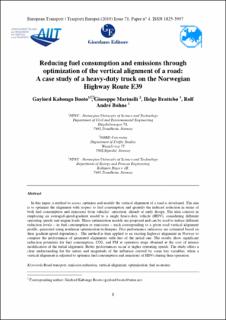| dc.contributor.author | Booto, Gaylord Kabongo | |
| dc.contributor.author | Marinelli, Giuseppe | |
| dc.contributor.author | Brattebø, Helge | |
| dc.contributor.author | Bohne, Rolf André | |
| dc.date.accessioned | 2020-09-16T07:40:42Z | |
| dc.date.available | 2020-09-16T07:40:42Z | |
| dc.date.created | 2019-03-27T11:10:41Z | |
| dc.date.issued | 2019 | |
| dc.identifier.citation | European Transport / Trasporti Europei. 2019, 71 . | en_US |
| dc.identifier.issn | 1825-3997 | |
| dc.identifier.uri | https://hdl.handle.net/11250/2677967 | |
| dc.description.abstract | In this paper, a method to assess, optimize and modify the vertical alignment of a road is developed. The aim is to optimize the alignment with respect to fuel consumption and quantify the induced reduction in terms of both fuel consumption and emissions from vehicles' operation, already at early design. The idea consists in employing an averaged-speed-gradient model to a single heavy-duty vehicle (HDV), considering different operating speeds and engine loads. Three optimization models are proposed and can be used to induce different reduction levels — in fuel consumption or emissions — each corresponding to a given road vertical alignment profile, generated using nonlinear optimization techniques. Five performance indicators are estimated based on their gradient-speed dependency. The method is then applied to an existing highway alignment in Norway to compare the performance of generated alignments with that of the initial one. The results show significant reduction potentials for fuel consumption, CO2, and PM at operation stage obtained at the cost of intense modification of the initial alignment. Better performances occur at higher operating speeds. The study offers a clear understanding for the nature and magnitude of the influence exerted by some key variables, when a vertical alignment is adjusted to optimize fuel consumption and emissions of HDVs during their operation. | en_US |
| dc.language.iso | eng | en_US |
| dc.publisher | EUT Edizioni Università di Trieste | en_US |
| dc.relation.uri | http://www.istiee.unict.it/europeantransport/papers/N71/P04_71_2019.pdf | |
| dc.rights | Navngivelse 4.0 Internasjonal | * |
| dc.rights.uri | http://creativecommons.org/licenses/by/4.0/deed.no | * |
| dc.subject | Bærekraftig infrastruktur | en_US |
| dc.subject | Sustainable infrastructure | en_US |
| dc.title | Reducing fuel consumption and emissions through optimization of the vertical alignment of a road: A case study of a heavy-duty truck on the Norwegian Highway Route E39 | en_US |
| dc.type | Peer reviewed | en_US |
| dc.type | Journal article | en_US |
| dc.description.version | publishedVersion | en_US |
| dc.subject.nsi | VDP::Miljøteknologi: 610 | en_US |
| dc.subject.nsi | VDP::Environmental engineering: 610 | en_US |
| dc.source.pagenumber | 33 | en_US |
| dc.source.volume | 71 | en_US |
| dc.source.journal | European Transport / Trasporti Europei | en_US |
| dc.identifier.cristin | 1688155 | |
| dc.description.localcode | Creative Commons Attribution 4.0 International (CC BY 4.0) license applies | en_US |
| cristin.ispublished | true | |
| cristin.fulltext | original | |
| cristin.qualitycode | 1 | |

